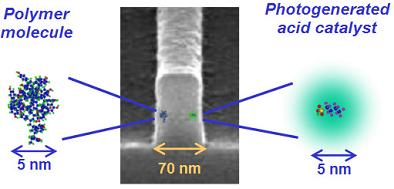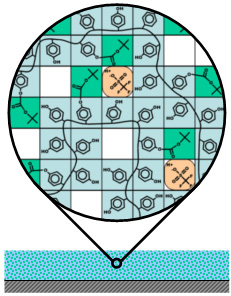|
|
|
|
|
Motivations
Process Flow |
Motivations The dimensions of printed photoresist features are now at a scale where the effects of individual molecules are important. The typical tolerance on the width of a photoresist feature is ten percent, and the maximum amount of roughness for a resist feature edge is 3-5 nm (3 sigma limit). The main components of photoresist are polymer molecules (> 90 weight percent) and photoactive molecules. Typical resist polymers are 5,000 to 10,000 MW, and have a radius of gyration of ~2-3 nm. The photoactive compound generates a catalyst molecule which is physically small, but due to the catalytic nature of the reaction it can affect a considerable volume of the resist.
The usual approach to lithography simulation is to treat the photoresist as a continuum material. These continuum simulations are very fast, and are often able to accurately simulate photoresist performance for a variety of process conditions. However, they rely heavily upon extensive calibration to expensive lithography experiments, and thus are limited in their predictive capability. Due to the continuum nature of these simulations, they are also limited in their ability to investigate stochastic phenomena such as feature roughness. In our mesoscale approach to resist modeling, the photoresist is represented as a three dimensional lattice of cells. Polymer molecules are represented as a string of cells, where each cell represents a repeat unit. Other lattice cells contain photoacid generator (PAG) molecules, photoproducts (acid molecules), solvent, free volume, etc. Each type of cell behaves differently in accordance with its chemical identity. Monte Carlo simulations are performed to model each lithographic processing step.
This mesoscale approach to simulation has several advantages. Because each molecular component of the resist is considered individually, it is now possible to simulate stochastic phenomena such as line edge roughness, microphase separation and clustering, shot noise during exposure, etc. Line edge roughness is a very important concern because variations in photoresist linewidth can cause semiconductor devices to fail, and a single failed device can often ruin an entire integrated circuit.
Another advantage is that it is now possible to simulate the effects of variations in the chemical composition of the materials. Chemical variables such as the polymer molecular weight and polydispersity, concentrations of photoactive component and casting solvent, concentration of the developer solution,etc. all influence the performance of the photoresist. By treating each resist component individually, variations in resist performance can be modeled based upon changes in the chemical formulation. This capability is of great value in the rational design of new photoresist materials.
Mesoscale simulation of resist performance requires very detailed mechanistic models for resist performance at a molecular level. We employ a variety of experimental methods to probe the chemistry and physics of resist performance at this scale. Details of these experiments can be found elsewhere on this website. Our simulations are based upon fundamental and measurable materials parameters that can be measured independently from lithographic performance. Ultimately, the goal of this research effort is a simulation that does not rely upon empirical fits to experimental data. Such a chemically detailed resist simulation with predictive capability would be a valuable tool in the rational design of new materials. |
|
|
Last
updated October 7, 2002 |
||





